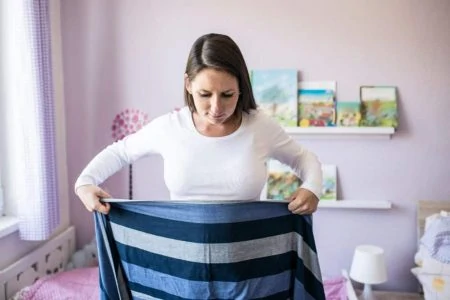Are you a proud baby-wearing mama with a dingy-looking carrier? Or maybe your big investment carrier was just the victim of a bad baby mess and must be washed ASAP. Do you feel clueless when it comes to how to wash your carrier?
We are very aware of the many ways carriers can get dirty. (Don’t ask about that mid-hike poop explosion!) Whether it’s sweat, spit-up, or worse, you want to keep your carrier clean.
But baby carriers can be expensive, and you want to clean them right so they don’t get damaged. They still need to maintain their integrity to support your baby’s weight.
In this article, we will discuss how to wash the many different types of carriers. We will also dive into special things you should consider when washing your carrier.
Key Takeaways
- Different carrier types require different cleaning methods: soft structured carriers, wraps, mei tais, and ring slings.
- Always follow the cleaning instructions specific to your carrier’s brand and fabric type.
- Use gentle detergents without bleach, fabric softeners, or optical brighteners, and avoid enzymes for silk or wool carriers.
- Air dry your carrier to maintain its integrity, shape, and color, and avoid potential fabric shrinkage.
How to Wash Different Types of Carriers
Not all carriers are created the same. Each carrier type comes with different bits and pieces you need to consider when cleaning.
Some carriers have buckles. Others are made of harder-to-clean fabrics such as silk or linen. All of these can change the way you need to wash your carrier.
Each baby carrier brand, and sometimes different carriers within a brand, will have a separate set of cleaning instructions. This might differ based on accessories, fabric, or how the carrier is made. Read the instructions for your carrier before starting the washing process.
1. Soft Structured Carriers
A soft structured carrier is what many parents think of first when they hear the term babywearing. They attach with buckles and have a soft padded band around the waist and shoulders to keep you comfortable when carrying your baby.
Many soft structured carriers can be worn with your baby on either your back or chest. Some enable you to carry your baby in a forward-facing position, and some are made with lightweight fabrics for hot summer months.
Some popular brands of soft structured carriers include Tula, Ergo, BabyBjorn, and Lillebaby. Just make sure the one you choose holds your baby’s hips at the correct angle to help prevent infant hip dysplasia (1).
You probably don’t need to do a complete wash of your soft structured carrier often. Instead, focus on spot cleaning most of the time. You can do this with a soft cloth, baby laundry detergent, and warm water.
For heavier cleaning, wash the carrier in cold water on the delicate cycle with a mild detergent. Air dry your carrier, and don’t use any bleaches, fabric softeners, or detergents with brighteners (2).
2. Wraps
A wrap carrier is a long piece of fabric you fold and knot around yourself to create a pouch to hold your baby. They are versatile and allow you to wear children of any size on your chest, back, or hips.
First, put your wrap in a pillowcase or lingerie bag so it will not get tangled in the machine. Your wrap can usually be washed in cold water on the delicate cycle using a mild detergent. What material your wrap is made of will determine whether or not you need to hang or tumble the wrap dry (3).
3. Mei Tais
A mei tai carrier is a cross between a wrap and a soft structured carrier. It has a structured pocket for your baby to sit in, but instead of straps and buckles, a mei tai has straps you wrap around yourself and tie to achieve the perfect fit.
You will want to wash a mei tai the same way you wash a wrap carrier. Place it in a pillowcase to prevent tangling, then wash it on the delicate cycle with cold water and a gentle detergent. Hang it out to air dry like you would a soft structured carrier.
4. Ring Slings
A ring sling is a one-shouldered baby carrier that allows you to carry your baby either on your front or hip. The sling is kept together by two rings attached to one end of the sling. You then weave the free end of the sling through the rings.
To wash a ring sling, unthread it from the rings so it can lay flat. Then wash it in cold water on the delicate cycle with a small amount of gentle detergent. Allow your sling to air dry, then iron it to maintain its shape.
Things to Consider Before Washing a Baby Carrier
Here are a few other things you want to think about before washing your carrier.
1. Fabric
Just as you would not wash a cotton sweater and wool sweater in the same way, you also would not wash a cotton carrier and wool carrier in the same way. Here is a basic breakdown of how to wash a carrier based on its fabric.
2. Blends
Blends need to be washed based on the most delicate fabric in the blend. For example, if your carrier is a wool/cotton blend, you will wash it based on the wool instructions. This will help you maintain the integrity of all the fabrics in the carrier.
3. Cashmere
This fabric is often used as a blend in a wrap or sling-type carrier. This fabric is super soft and should never be washed in a machine. Instead, you can either spot clean it with cold water as needed, have it dry cleaned, or hand-wash it gently.
To wash a cashmere blend carrier by hand, fill a basin with cold water and a little bit of gentle detergent. Place the carrier into the water and gently swish it around for one minute, but do not scrub!
Roll the carrier into a towel to gently ring out any excess water. Lay it flat to dry to help it maintain its shape. It’s important to lay the carrier flat because you do not need to iron a carrier made from cashmere.
4. Wool
Wool is a delicate fabric, and it can easily become felted if you are not careful. Hand-wash this type of fabric in a little bit of lukewarm water with a gentle detergent (4). Keep the water at a consistent temperature, and do not twist or ring to dry — this will help you avoid felting.
5. Bamboo Viscose
With bamboo viscose, you need to ensure you don’t keep it in the water too long. Let it be in the water for only 40 to 50 minutes maximum, and do not rub, ring, or soak the fabric. Hang it to dry, and iron it with steam to help it maintain its shape.
6. Cotton or Linen
Wash cotton or linen alone in cold water with a little bit of gentle detergent. Use the delicate cycle, then hang to dry.
You can dry these fabrics in the dryer on a low setting, but remember that they will shrink a bit since they are a natural fabric. Because of this, many choose to hang these fabrics to dry.
7. Silk
The way you wash a silk sling or wrap will depend on how you want your sling to look. If you want to maintain the silk’s shine, spot clean the fabric with a bit of cold water or dry-clean it.
If you want your carrier to have more of a matte finish, you can wash it in cold water with a gentle detergent on the delicate cycle. Add a quarter cup of vinegar to your rinse cycle to help keep the fabric soft. Silk can shrink in the wash, so gently stretch it back to size while still damp to maintain its shape.
8. Detergent
To maintain the color and integrity of your carrier’s fabric, use a gentle yet effective detergent.
Pro Tip
Why Air Dry?
Drying your carrier — or any fabric — in the dryer can result in the breakdown of the fabric due to the high heat the dryer uses.
Drying fabrics in the dryer can also cause them to shrink, which could ruin your carrier. Because of this, many choose to dry their carriers on a line. Just make sure to dry it inside and away from direct light so the fabric’s colors do not fade.











